The graphic design industry has boomed in the digital age and has proven beneficial for minor and major businesses. Graphic designers work hand in hand with organizations to build their brand, connect with potential consumers, compete in the industry, and garner audiences’ attention.
Graphic design is present in every business aspect because of corporate branding, web design, print production, social media content, and other touchpoints that engage audiences with visuals. Compared to different types of content, the visual stimulation that graphics offer can elicit emotions that increase your business appeal and brand awareness.
Learning about graphic design statistics can give you insight into the industry. In contrast, brands can learn about the potential benefits of investing in graphic designers’ work.
Here’s a rundown of the stats we’re going to cover:
- Graphic Design Industry Trends
- Industries That Need Graphic Designers
- Small Business Graphic Design Statistics
- Business-to-Business (B2B) Graphic Design Statistics
- Digital Marketing and Visual Content Statistics
- Branding and Web Graphic Design Statistics
- Logo Statistics
- Color Use Statistics
- Graphic Design Software Use Statistics
- Social Media Marketing Graphic Design Statistics
- Consumer Behavior Graphic Design Statistics
Graphic Design Industry Trends
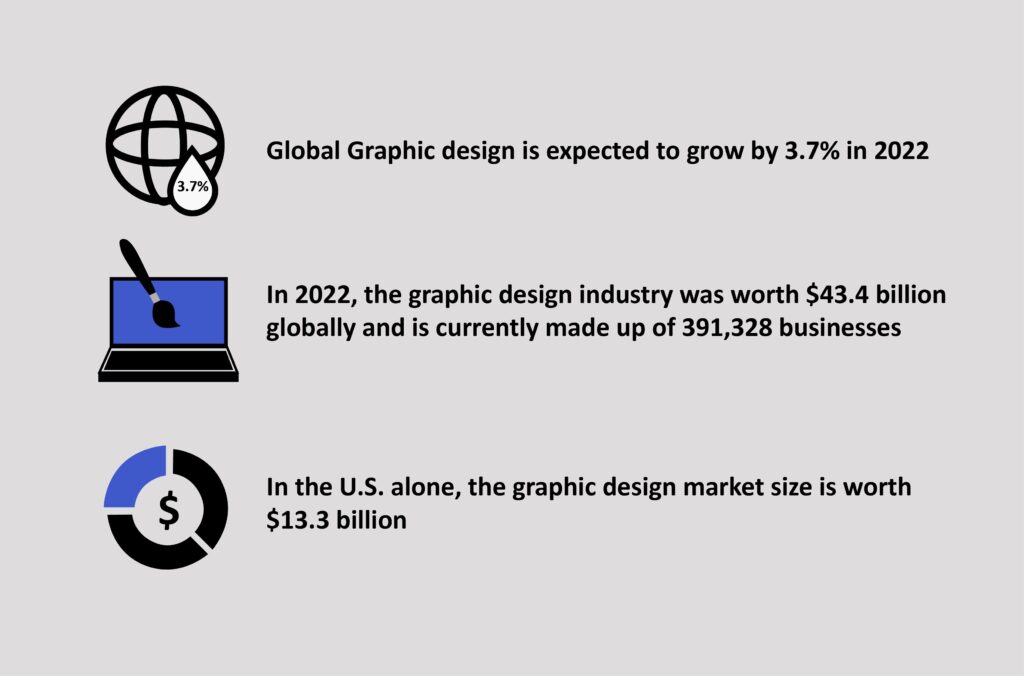
With technology constantly advancing, the graphic design industry has experienced growth like no other, with the global graphic design market expected to grow by 3.7% this year. In 2022, the graphic design industry is expected to be worth $43.4 billion globally and is currently made up of 391,328 businesses.
As companies increase their digital presence, graphic designers work on advertisements, reports, magazines, brochures, and other layouts on websites.
- Global graphic design is expected to grow by 3.7% in 2022
- In 2022, the graphic design industry was worth $43.4 billion globally and is currently made up of 391,328 businesses.
- In the U.S. alone, the graphic design market size is worth $13.3 billion
- Between 2017 and 2022, the global graphic design industry has grown by 0.6% every year on average
- There are an average of 23,900 job openings for graphic designers every year
- The demand for graphic designers will continue to grow by 3% from 2020 to 2030
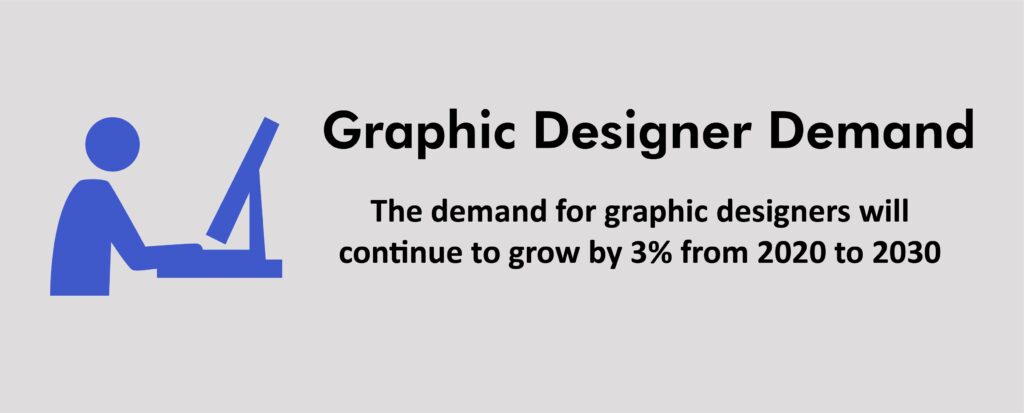
Despite only 15% of digital marketers utilizing the help and skill of freelance graphic designers, freelance graphic designers make up 90% of the entire industry. This industry is vital in any brand marketing and selling products, and a graphic designer’s skill is a combination of technology, software, or designs by hand that create visual concepts.
- 15% of digital marketers hire freelance graphic designers
- 90% of the graphic design industry is made up of freelancers
- On average, graphic designers earn $53,380 annually though they may be able to increase that with various artist side hustles.
- Although their average salary is lower compared to men ($46,317 per year), more than 50% of graphic designers are women, and probably even more females can be added to this number if you consider who does it as a side hustle.
- Male graphic designers will have an average salary of $55,585
- The average wage for a graphic designer is $26 per hour
- In the U.S., the average age for a graphic designer is 37 years old
- 76.1% of graphic designers are White, 10.2% are Latino or Hispanic, while 7.6% are of Asian ethnicity
However, these statistics will change depending on the skill level and expertise of a professional graphic designer:
- An entry-level designer is a beginner graphic designer that has just entered the industry and has little to no experience.
- A junior graphic designer has an average level of knowledge and skill, which has accumulated over the past few months to 3 years.
- High-end or senior graphic designers can also act as mentors to junior graphic designers because of their three years to 5 or more years of experience.
Freelance graphic designers, on the other hand, are more likely to charge businesses for their services per project:
- An amateur graphic designer may already have a portfolio but have not received a formal education in graphic design, so they have lower rates per project.
- Junior freelance graphic designers are more educated with more than a year of experience and usually work part-time.
- Senior graphic designers have a comprehensive portfolio due to their education in graphic design in addition to industry-specific courses. Usually full-time, this type of graphic designer is highly-qualified and experienced.
- Exclusive professional freelance graphic designers work full-time and have clients in the digital advertising and press space. Most graphic designers with this status have years of experience and are famous for their work.
Sources: ibisworld.com, ibisworld.com, bls.gov, venngage.com, ibisworld.com, bls.gov, datausa.io, ons.gov.uk, ziprecruiter.com, zippia.com
Industries That Need Graphic Designers
Aside from being a graphic designer, those with a degree or relevant experience can also become:
- Creative directors
- Art directors
- User experience (UX) designers
- User interface (UI) designers
- Production artists
- Product developers
- Marketing specialists
- Multimedia artists or animators
- Web designers or developers
- Digital illustrators
- Technical writers
- Photo Editor
- Industrial designers
- Drafters (Engineering and Architecture)
- Desktop publishers
- Craft or fine artists
- Logo designer
- Creative services manager
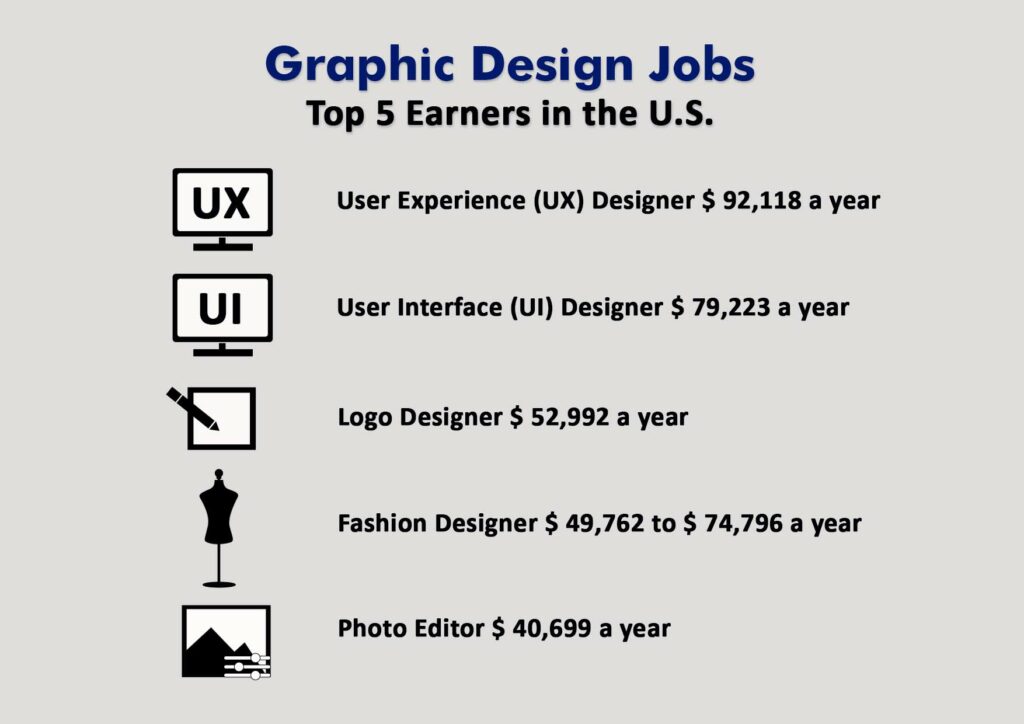
Out of all graphic design jobs, the top 5 earners in the U.S. include:
- User experience (UX) designer: $92,118 a year
- User interface (UI) designer: $79,223 a year
- Logo designer: $52,992 a year
- Fashion designer: $49,762 to $74,796 a year
- Photo editor: $40,699 a year
While all industries can benefit from a graphic designer’s skill set, graphic designers are often found in the fields of:
- Education
- Publishing
- Computer systems design
- Mobile application design
- Government organizations
- Advertising
- Manufacturing and packaging
- User experience
Some U.S. industries invest in graphic designers more than others:
- Monetary authorities-central bank: $108,260 a year
- Software publishers: $94,780 a year
- Natural gas distribution: $90,240 a year
- Federal executive branch: $88,430 a year
- Securities, commodity contracts, financial investments, and related activities: $86,730
However, becoming a graphic designer is not for everyone, with 40% of those entering the field quitting after two years.
- 40% of graphic designers quit within 2 years of becoming one
- Only 60% of 25,000 people who pursue a graphic design career last the first two years
- ⅓ of graphic designers stay in the profession after five years
Sources: indeed.com, indeed.com, indeed.com, salary.com, indeed.com, bls.gov, PrincetonReview.com
Small Business Graphic Design Statistics
Small businesses invest in graphic designers to create visual assets to stand out and market successfully.
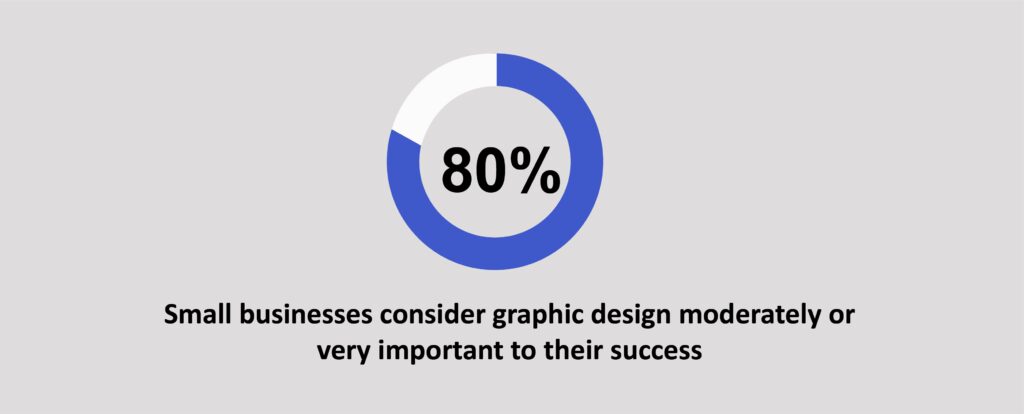
- 80% of small businesses consider graphic design moderately or very important to their success
Sources: visual.ly,
Business-to-Business Graphic Design Statistics
Graphics and visuals are just as crucial for businesses with other businesses as customers.
- 51% of B2B marketers prioritize visual asset creation
As for the type of content B2B marketers use for content:
- 72% use video content
- 65% use infographics
- 56% use illustrations and photos
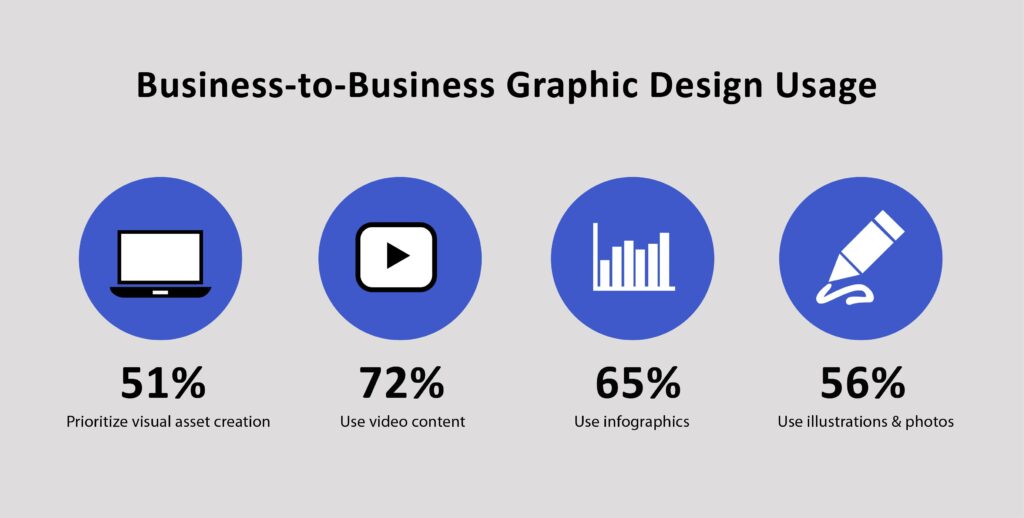
With the help of a graphic designer, high-quality content incorporated into a brand strategy can present data and messages in a way that stays with audiences.
Sources: contentmarketinginstitute.com, contentmarketinginstitute.com
Digital Marketing and Visual Content Statistics
Visuals and graphics are powerful tools in digital marketing because visual information is processed 60,000 times faster than words are. For example, after analyzing 100 million articles, posts would see an increase in Twitter and Facebook shares by including at least one image in the content.
A post with at least one image would have twice as many people share it. Combining text with relevant images can increase how much your audience will remember it by 650%.
- Our brains process visual information 60,0000 times faster than words
- A study analyzing 100 million articles found that Twitter and Facebook posts would see an increase in shares if there is at least one image in the content
- Content with at least one image will be shared by twice as many people compared to a post without visuals
- Text combined with relevant images can increase how much an audience will remember it by 650%
However, content marketers face the following challenges in producing visuals and designs:
- 36.7% say the biggest roadblock is consistently generating graphics
- 22.9% say that finding the appropriate layout is challenging
- 20.5% of digital marketers say that having a great design is difficult
- 19.9% have difficulty finding data sources
- 12% find getting a broader reach challenging
As to the kind of visuals that digital marketers believe contribute to their marketing goals, some are more effective than others:
- Custom graphics (e.g., illustrations and infographics): 40.8%
- Videos and presentations (e.g., slideshows and webinars): 23.7%
- Charts and data visualizations: 15.4%
- Stock photos: 8.9%
- Multi-page documents (e-books and white papers): 8.4%
- 40% of organizations would like the graphic design process to be automated
- 48% of content marketers use 91% to 100% of their content, including visuals
- 62% of marketers use visuals as part of blog content or a website’s landing page, which can be made easier with a graphic designer-friendly website builder.
- 88% of marketers believe that visuals are a must-have for 50% of website articles
- 56.6% of marketers pivoted their visual content marketing strategy due to the pandemic
- 85% of shoppers say that pictures that accompany product information are essential when it comes down to deciding what brand or retailer to shop from
Sources: multimedia.3m.com, okdork.com, yumpu.com, venngage.com, thinkwithgoogle.com
Branding and Web Graphic Design Statistics
Visual elements that can establish a business’s identity include package design and logos. How attractive your website and products are can influence how potential consumers will see what you have to offer because 94% of first impressions of a brand or company are design-related.
Whether you’re a graphic designer or a brand, a good branding strategy considers the impact of different elements. Part of the branding journey can include A/B testing different layouts, color schemes, fonts, etc., to see which versions of visuals will benefit your business better. These are elements that should be considered because 75% of people judge how credible a brand is based on its website.
- 94% of first impressions of a brand or company are design-related
- 75% of people judge how credible a brand is based on its website
- 73% of companies invest in design to stand out from their competition
- 84.6% of graphic designers believe that crowded design is the top design mistake, followed by having no CTA buttons (38.5%)
- Globally, 59% of users prefer appealing designs, while 41% prefer plain and simple designs
- 94% of consumers will cite a website’s design as the main reason why they distrust a site
- 6 out of 10 shoppers say that how usable a website is what they find important when shopping online
Sources: researchgate.net, credibility.stanford.edu, adobe.com, goodfirms.com, landing.adobe.com, statista.com
Logo Statistics
Designing logos is one of the essential things that a graphic designer does and is a crucial pillar in the graphic design industry in the U.S. Logo design and branding make up nearly $3 billion of the total graphic design market. Of course, there are a lot of logo markers on the market that use AI to do this, but a dedicated graphic designer is always preferred.
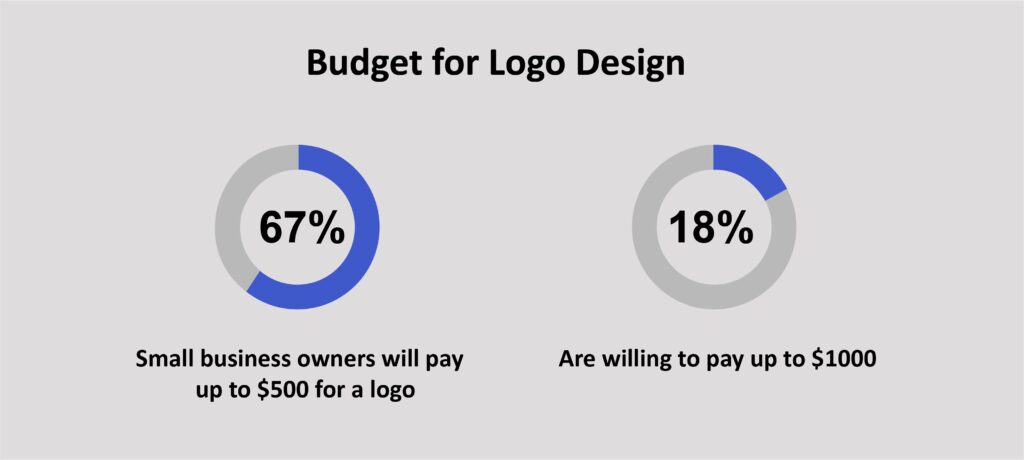
- Logo design and branding make up about $3 billion of the entire graphic design market
- Due to graphic design costs, only 67% of small business owners will pay $500 for a logo, and only 18% are willing to pay up to $1000
- 60% of consumers admit that even if a brand has good reviews, they’ll avoid it if the brand logo is unattractive, unappealing, or odd
- People spend about 6.4 seconds focusing on a brand’s logo when they visit a website
- 60% of top 500 companies use combination logos which are a combination of logotype and logomark
- 73% of leading brands use sans serif fonts
- 40% of leading brands include the color blue in their logos
- A survey was conducted in 10 countries across four continents shows that blue is the most popular favorite color and has a positive association
Sources: ibisworld.com, studyfinds.org, news.mst.edu, websiteplanet.com, today.yougov.com
Color Use Statistics
Using the right colors in graphics can boost a website’s conversions. A study focusing on Performable changed its call-to-action (CTA) buttons from green to red and left all other elements as they were. By simply changing the color, Performable saw its conversion rates increase by 21%.
Similarly, Ript Apparel saw a 6.3% increase in sales after changing its CTA buttons from green to yellow. Graphic designers use color theory and psychology to create content that effectively reaches audiences.
- Performable’s conversion rates increased by 21% by changing its CTA buttons from green to red
- Ript Apparel’s sales increased by 6.3% after changing its CTA buttons from green to yellow
- 90% of the time, the initial gut reaction to products is based on color alone.
- Color can improve readership by 40% and boost comprehension by 73%.
- Colored logos have an 80% chance of increasing brand awareness
Sources: blog.hubspot.com, vwo.com,emerald.com, colorcom.com, ragan.com
Graphic Design Software Use Statistics
Gripping visuals will intrigue an audience, and drawing software is a practical graphic design tool.
The most common software that web designers use includes:
- Photoshop: 88.5%
- Illustrator: 76.9%
- Sketch: 75%
- InDesign: 23.1%
How Long Does it Take to Create Visuals?
- 50% of marketers spend less than 5 hours
- 22% spend 5 hours to 10 hours
- 29% spend 10 to 20 hours
Sources: goodfirms.co, venngage.com
Social Media Marketing Graphic Design Statistics
Social media is a source of news, entertainment, communication, and inspiration which is why it has become an effective digital marketing platform. As one of the most popular activities online, social media users are expected to reach 4.41 billion by 2025.
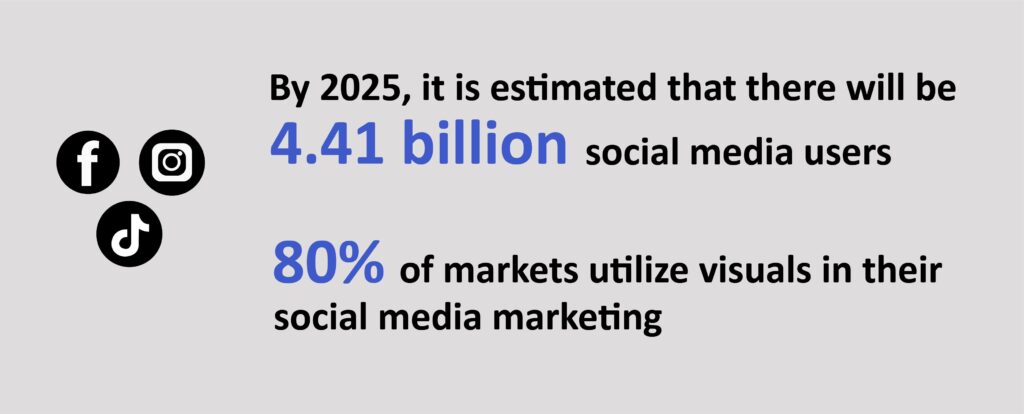
- By 2025, it is estimated that there will be 4.41 billion social media users
- With over 3.6 billion potential consumers in 2020, graphic design is essential in competing in social media, a competitive landscape
- Internet users, on average, will spend 144 minutes on social media and messaging apps every day
- 80% of markets utilize visuals in their social media marketing
- People are two times more likely to share video content over other types of content
- 84% of consumers agreed that promotional videos convinced them to make a purchase
Sources: statista.com, socialmediaexaminer.com, wyzowl.com
Consumer Behavior Graphic Design Statistics
Visuals on a website are essential on all platforms, with 85% of consumers aged 18 years old to 49 years old using multiple devices simultaneously. In this digital age, it’s not surprising that 50% of revenue for an eCommerce store is generated on mobile devices. Despite this fact, mobile conversion rates are lower than desktops because most mobile sites are slow and have too many elements.

- 85% of consumers aged 18 years old to 49 years old use multiple devices simultaneously
- 50% of revenue for an eCommerce store is generated on mobile devices
The probability of a visitor bouncing or leaving a website depends on how long it will take a website to load. As page time increases from:
- 1 second to 3 seconds bounce probability increases by 32%
- 1 second to 5 seconds bounce probability increases by 90%
- 1 second to 6 seconds bounce probability increases by 106%
- 1 second to 10 seconds bounce probability increases by 123%
- 65% of the population are visual learners
- It takes 50 milliseconds for consumers to decide whether or not they will stay on their site
- 92.6% of customers say that the visual dimension is the most influential factor affecting their purchasing decisions
- 94% of consumers will leave a website with poor design
- 66% of consumers want to look at a website that has been beautifully designed
- When a brand invests in user experience (UX) with a functional and beautiful site, $100 is returned for every $1 spent. This is a return on investment (ROI) of 9,900%
- If your website has no contact information, 54% of consumers think that the lack of this design element reduces a brand’s credibility
Sources: thinkwithgoogle.com, statista.com, thinkwithgoogle.com, semanticscholar.org, tandfonline.com, loyaltysquare.com, sweor.com, forrester.com, komarketing.com
